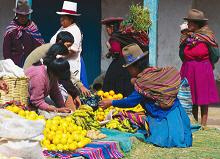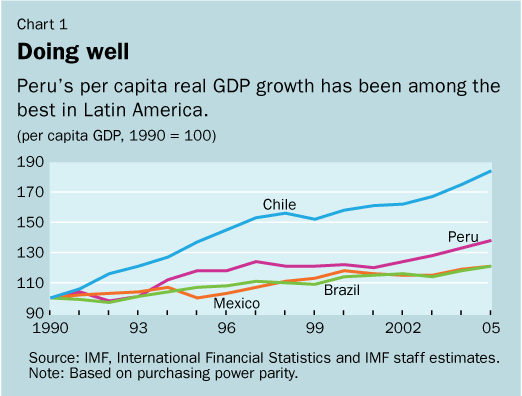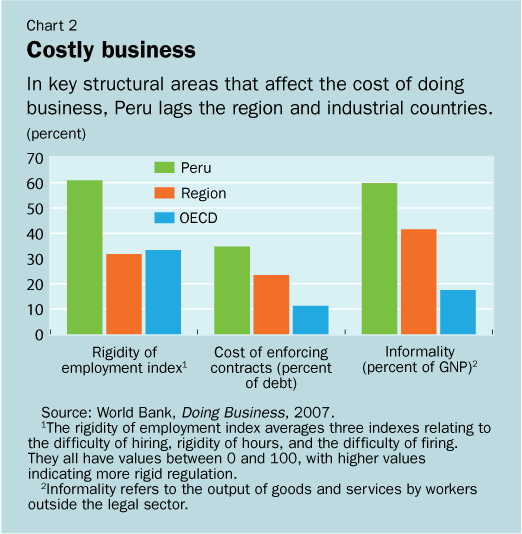
Typical street scene in Santa Ana, El Salvador. (Photo: iStock)
IMF Survey: Poverty Remains High Despite Peru's Growth
September 19, 2007
- Peru's recent economic performance has been among best in Latin America
- But despite some improvement, poverty remains stubbornly high, widespread
- New program, supported by IMF, seeks further inroads against poverty
Peru's economic performance has been one of the strongest in Latin America as a result of nearly two decades of sound economic policies.

Buying fruit in a market in Peru where, despite strong growth, poverty remains stubbornly high. (photo: David Lorenz Winston/Picture Arts)
Latin America
Its real GDP growth has averaged 5 percent a year since 2000, among the region's highest, while average inflation, at 2 percent, is among the lowest (see Chart 1). Net international reserves reached $24 billion (or about 160 percent of foreign currency deposits) in August.

Still, poverty remains widespread and the government of President Alan Garcia, who took office in July 2006, has targeted poverty in its economic policy program. To support that policy, Peru requested a new Stand-By Arrangement with the International Monetary Fund. The 25-month arrangement, for about $250 million, was approved in January, and its first review, in June, was successful. Peruvian authorities are treating the arrangement as precautionary, as did earlier governments with their Fund-supported programs.
Progress against poverty
Peru's good performance has resulted in some progress against poverty, but almost half of the population is still indigent, particularly in rural areas. To help reduce that poverty, the economic policy program developed by President Garcia and his economic team centers on consolidating macroeconomic stability and advancing reforms to enhance the effectiveness and broaden the coverage of social assistance programs.
These efforts will be complemented by measures to improve the business environment, strengthen the resilience and depth of the financial system, reduce high labor market informality, and further open the economy. The key elements include:
Consolidating macroeconomic stability. The authorities' fiscal program for 2007-08 targets overall deficits well below the legal ceiling of 1 percent of GDP to assist macroeconomic stabilization and keep the debt-to-GDP ratio on a steady downward path. In fact, buoyant revenues driven by favorable external conditions and strong domestic demand could help the consolidated public sector achieve balance or even a surplus for the second consecutive year in 2007.
Broader revenue base
This prudent fiscal stance still contemplates a significant rise in public expenditure to address pressing social and infrastructure needs. To strengthen fiscal policy further, the government has broadened the revenue base, mainly by reducing pervasive tax exemptions, and intends to improve the quality of spending, including through reforms of the National System of Public Investment.
To solidify the credibility of the inflation targeting framework, the authorities are considering greater exchange rate flexibility and promoting more widespread use of financial hedges, which would increase the overall resilience of the highly dollarized economy. All these policy efforts will be complemented by active debt management to improve the currency composition, cost and maturity profile of public debt.
A recent agreement with Paris Club creditors to prepay about $1.8 billion in non-concessional debt in October and issuance of a 30-year bond denominated in Nuevos Soles are testimony to the authorities' skillful management and improvements in Peru's external viability.
Tackling high poverty. Despite strong growth rates, poverty has remained stubbornly high, especially in rural areas such as the Andean highlands and the Amazon basin. Chronic malnutrition of infants in rural areas remains significant, at around 40 percent, and educational quality is low by regional and international comparison.
Moreover, the large number of social assistance programs (SAPs) has made it complicated to monitor them properly and weakened their effectiveness. Many of the resources channeled through these programs did not reach the intended recipients.
New program against malnutrition
As a first step towards enhancing their focus and effectiveness, the government recently consolidated 82 SAPs into 26 programs, and intends to complete updating the single registry of beneficiaries and the household targeting system—steps that are critical to adequately register beneficiaries. It has also just launched a new program, Crecer, which relies on a coordinated approach to combat chronic malnutrition in young children.
Crecer will initially focus on the deprived Huanuco region, before being expanded nationally. The conditional cash-transfer program Juntos is expected to reach 350,000 families by end-2007. Juntos requires, among other things, recipients to meet certain requirements with regard to health, nutrition and education.
The government's efforts in these areas will be complemented by an agreement with mining companies, which will voluntarily contribute about $750 million over the next five years to finance social and infrastructure outlays in the communities they operate in, as long as commodity prices and associated profits remain high..
Strengthening the financial system. Reducing financial dollarization, which will help strengthen the resilience of the banking system to exchange rate shocks, is another critical objective of the program. In August, about two-thirds of the banking system's credits and deposits were in dollars. About 85 percent of mortgage credit is denominated in dollars, but most borrowers rely on local currency income to pay the real estate loans. That makes their ability to pay vulnerable to exchange rate movements.
Capital market development
One key element of the Garcia economic program entails phasing out government subsidies to foreign-currency denominated mortgages, while continuing its support for domestic currency mortgages. This de-dollarization effort will be assisted by measures to allow for a better internalization of risks and to deepen capital markets. In this regard, the authorities have committed to strengthening bank regulations dealing with foreign-currency risks and to addressing remaining legal and regulatory obstacles to capital market development.
Boosting long-term growth prospects. Peru lags in critical structural areas that constrain growth and induce elevated levels of informality (see Chart 2). While recent World Bank Doing Business indicators show some progress, significant gains can still be made in such areas as labor market flexibility and contract enforceability.

The government plans to continue its efforts to improve the business climate and competitiveness, by such actions as simplifying regulatory requirements, extending the commercial court system beyond Lima, enhancing labor market flexibility, and further opening the economy. An amended Free Trade Agreement (FTA) with the United States . has recently been ratified by the Peruvian Congress and is pending ratification by the U.S. Congress.
While Peru's immediate outlook is exceptionally strong, the government is aware of lingering vulnerabilities. It is critical that the authorities consolidate macroeconomic stability, enhance the business environment, and swiftly reduce high poverty. Recent efforts to step up assistance to local governments in developing basic infrastructure and technical capacity are particularly important to alleviating poverty.
Also, while exports remain dominated by primary commodities, sustained trade liberalization would help entrench the sharp increase in nontraditional exports, and assist regional development. Moreover, a comprehensive reform of labor market legislation would help reduce informality, boost labor productivity, and assist poverty alleviation efforts by expanding formal employment and raising incomes


